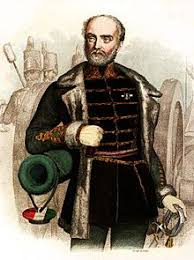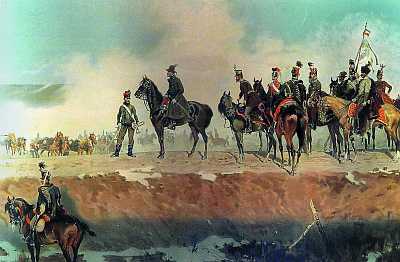
A hero of two nations, great commander, swashbuckler and a "gun for hire". A script for a Hollywood blockbuster, be it an action film an epic historical film, could easily have been written on the basis of his life story, without the slightest need to spruce it up. That's what general Józef Zachariasz Bem was like.
As is often the case, a hero of two nations, was himself from somewhere else. The Bems, with their own family coat of arms, were descendants of German bourgeoisie residing in Silesia. During the Stanisław August Poniatowski era, the grandfather of the future general joined the ranks of the Polish nobility (szlachta). Through skilful management of its estates and beneficial marriages the family became quite wealthy. Józef Bem was born in Busko near Tarnów on 14 March 1794. Soon after the Bem family moved to Kraków, where young Józef attended St. Anne's Secondary School. As a fifteen year old he enrolled at the Application School of Artillery and Engineering for future Dutchy of Warsaw army officers. The school furnished him with excellent background engineering knowledge within the scope of geometry, arithmetic, military engineering and artillery tactics. Apart from military subjects, foreign languages were also taught at the school – Bem mastered Russian, French and German. Just as any officer from that epoch, he was expected to be able to dance well, ride horses, wield a sabre and an épée.
As an 18 year old lieutenant, Józef Bem took part in his first military campaign – Napoleon's 1812 invasion of Russia. Then he fought in the 1813 campaign. He received the French Legion of Honour for bravery and military merits. After the fall of Napoleon and the establishment of the Kingdom of Poland, he served in the Kingdom's army in the rank of a captain. Apart from works associated with the development of the artillery and military engineering, he was also engaged with the development of rocket weapons. As a result of his research, the first rocket weapons formation in the Polish army was established – a rocketeer battery, which subsequently became famous during the November Uprising.
The future Spring of Nations hero was also fairly active in non-military affairs, which was a cause of innumerable problems for him. He was accused of National Masonry membership, which was prohibited within the Kingdom's military. He duelled, he was insubordinate towards his superiors and was subsequently forced to quit the Kingdom's army. He was probably an outlandish swashbuckler at that time; in a duel, killing his opponent he also suffered a bullet wound to his leg resulting in a limp which he nursed throughout his life.
After decommissioning he went to Galicia, where he managed an estate leased from his paternal uncle, became involved with engineering undertakings and theoretical works on military technology.
When news of the Uprising in the Kingdom of Poland reached him, he made his way to Warsaw, where in March 1831 he assumed command of the 4th horse artillery battery in the rank of a major. He became renowned as an excelled commander of such a formation, combing thorough engineering knowledge with fearlessness. Accurate bombardment from guns commanded by Bem was able to disrupt a more numerous enemy. Galloping horse artillerymen, led by their commander, under enemy fire, took up superior firing positions, fired a number of salvos and quickly moved to another position. Bem proved to be an outstanding commander in the Battles of Domanice, Iganie, Orzyc and Długosiodło. He was soon promoted to the rank of lieutenant colonel. In the lost Battle of Ostrołęka, the heroic horse artillery charge led by Bem allowed time Polish units, which by that time were in disarray, to regroup and avoid further losses. In that battle, the colonel was wounded.
In June 1831 Bem was part of Warsaw's defence, already as a brigadier general in command of field artillery.
He emigrated after the fall of the uprising. He mainly stayed in Paris, where he became involved in politics amongst Polish immigrants. He run classes for officers, wrote theoretic papers, and when his financial situation was dire – he painted images which he then sold.
Upon receiving news of the outbreak of the Spring of Nations within the Hapsburg dynasty, he made his way to Vienna. During the short-lived revolution in the Empire's capital, he became the actual, if not nominal, commander of the defenders. The fighting did not last long and without the necessary determination of the capital's residents it was doomed to failure, nonetheless the general managed to suffer yet another wound caused by an exploding artillery shell. After the capitulation of Vienna, he did not want to be imprisoned and went to Hungary in disguise, where, at that time, the revolution evolved into a National Uprising. The Hungarians, with a view of expanding the reach of the uprising across the historic Kingdom of Hungary, were particularly keen to capture Transylvania, the historic region associated with the traditional lands of the Hungarian Crown. Transylvania is extremely picturesque, whilst at the same time it is an area where conducting military operations is difficult. Surrounded on three sides by the curving Carpathian mountain range, spanning a hillish highland, it was home to a real smelting pot of peoples, languages and religions. Since ages gone by it was inhabited by Hungarians and the related Székelys, hardy defenders of the Carpathian borderlands; German folk dominated the towns whereas rural areas were mostly populated by Romanians. There was no shortage of Gypsies and Jews in Transylvania. Understandably the Hungarians and Székelys were wholeheartedly behind the ideals of the Uprising, whereas the Germans and the Romanians opposed them.
Lajos Kossuth, the leader of the Hungarian uprising desired to win control over Transylvania and sent general Józef Bem there, with the hope that this experienced, hardy commander will manage to tip the scales in favour of the insurgents. He was not disappointed.
Initially general Bem's Transylvanian army numbered just a few thousand soldiers. Under great leadership, it began achieving subsequent successes in the lighting 1848/1849 winter campaign against the imperial forces. Once again, Bem showed himself to be an aggressive, offensive leader, able to expertly move his forces and outstandingly command his favourite artillery using the available lay of the land. The general's staff included Poles and Hungarians, with Sándor Petőfi, the most prominent representative of Hungarian Romantic poetry amongst the latter. He lauded his commander in a poem and news of ensuing victories spread across the entire Hungary. Petőfi's most famous poem from that time was the "Transylvanian Army"

Shan't we be victorious? – Bem is our leader,
A night of freedoms and glory!
With the fire of vengeance, burning before us-
Ostrołęka's bloody star.
(…)
Translated into Polish from the original by Tadeusz Fangrat.
It took Bem three months to oust Hapsburg forces from Transylvania. In areas under his control he established the infrastructure necessary to support his still meagre army. Once again shining as an engineer, he set up gun foundries, weapons manufacturing facilities and powder mills. As the lion's share of Székely volunteers flocking to his army were only armed with war scythes. Thus, once again the general had scythe-men under his command, however instead of Mazowsze garb they now wore brown, braided Transylvanian coats.
Poles eagerly joined the Transylvanian forces, with the hope that in fighting for the Hungarian cause they will also contribute to Poland's independence. Initially they were part of Hungarian units, as the uprising commanders were weary of establishing separate Polish formations in order not to enrage Russia, which eventually proved futile anyway...
In Transylvania the Hungarians had a hardy, even if not always well equipped infantry, well commanded artillery and excellent hussars, well known for their military prowess. However, they were lacking cavalry armed with pole weapons, useful in charging against the enemy. The seed of a Polish lancer regiment was established under the command of colonel Łoś, who quickly proved that they are no strangers to the lance, the Polish national weapon. In total two legions were formed during the course of military operations in Hungary: one commanded by Wysocki, fighting alongside the main uprising forces and the other in Transylvania, commanded by Bem.
Unfortunately, the superpowers which held Poland subdued, also came to an agreement within the scope of quenching the Hungarian uprising. A 40 thousand man strong intervention corps marched into Transylvania, which, together with the 16 thousand man strong Austrian corps was overwhelmingly superior to general Bem's army, numbering a dozen or so thousand. Despite the enemy's numerical superiority, the general did not shy away from the fight, evading the main forces and striking back. Sándor Petőfi was killed in the Battle of Sachsburg (today's Sighișoara), however, Bem's units managed to retreat. In the end the insurgents were ousted from Transylvania and ousted further west, into the Hungarian Plain. In these final days of the uprising, Kossuth ceded overall command of the Hungarian army to Bem, however, faced with overwhelming Russian - Austrian forces, there was little which could have been done. The Battle of Temesvár took place on 9 August 1849, which sealed the fate of the uprising. Right at the outset Bem suffered another wound, and the Hungarian forces were defeated.
Together with the fall of the Hungarian uprising, began the last chapter in the general's life. Not looking forward to imprisonment nor to the gallows, he crossed the border and made his way top Turkey. There he joined the Ottoman army, and as every Turkish soldier had to be a Muslim – he converted to Islam. He was stationed at the a garrison in Aleppo, where, amongst other things he pursued geological research. Soon he managed to being a sizeable group of P:olish officers to the city and had plans to open an artillery school there. These plans were thwarted by internal unrest plaguing the Ottoman Empire at that time. An Arab revolt broke out around Aleppo, directed at the Turkish administration and the local Christian community. A siege was laid to the city and the general, for the last time in his career was in command – as an artillery commander. The defence was successful, however the general caught malaria, which overpowered his fatigued body. He dies in November 1850 and was buried at the local Muslim cemetery. The general's remains, brought back to Poland during the inter-war period, were laid to rest in his family town of Tarnów.
He was a hero and a legend already during his lifetime. Hungarians worshipped him as the commander of an army which had more victories than defeats. There is a street or a square named after him in every Hungarian town. The general's monument, erected in Budapest in 1929 is an important site on the historic map of the city, a venue for patriotic meetings and manifestations. Many books have been written both academic as well as popular science, depicting Bem's story. However, we are still waiting for a film, based on the general's life story, which would make even more people aware of his exploits.
Marcin Bąk